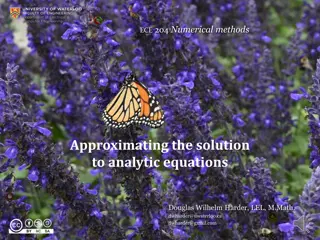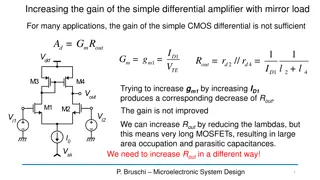Exploring Differential Games and Their Practical Applications
Differential games involve dynamic systems where players control their strategies to optimize objectives. Initially used for military analysis, these games are now applied in economics and engineering. A specific example is the Homicidal Chauffeur Game, illustrating strategic maneuvering between players. The methodology involves determining the value of payoff under optimal strategies through a family of potential initial conditions. These games are analyzed through various scenarios and strategies to achieve optimal outcomes.
Uploaded on Oct 10, 2024 | 0 Views
Download Presentation

Please find below an Image/Link to download the presentation.
The content on the website is provided AS IS for your information and personal use only. It may not be sold, licensed, or shared on other websites without obtaining consent from the author. Download presentation by click this link. If you encounter any issues during the download, it is possible that the publisher has removed the file from their server.
E N D
Presentation Transcript
DIFFERENTIAL GAMES AND ITS APPLICATIONS Presented by Kyathi Neeharika Adusumalli (1002031065)
Introduction Examples OUTLINE Applications Brief explanation of paper
INTRODUCTION In Game Theory, Differential games are the group of problems where state variable(players) evolve over time according to differential equation. In a differential game, each player controls a dynamic system described by a set of differential equations. The players' strategies are characterized by their choice of control inputs to their respective systems, and the players aim to optimize some objective function, such as maximizing their own profit or minimizing their opponent's profit. Early analyses reflected military interests, but recent analyses uses this type of games concept in economics and engineering.
HOMICIDAL CHAUFFEUR GAME P and E can move in a plane with speed V2 and V1 with V2>V1. E is more maneuverable where P is less maneuverable. Time of capture is the Pay-off. There is some fixed region attached to P which is called capture region. When E enters that region capture occurs. Both players have full information.
HOMICIDAL CHAUFFEUR GAME CONT. For a Prototype , think a car is whose driver is trying to catch a pedestrian in a large unobstructed parking lot. Some qualitative analysis evident that, If E is more or less Infront of P the situation is simple. E will flee and P will follow. But as you see in Fig 1, let P is at P0and E is at E0 which is ,to say, at right rear to P0. If P is na ve enough to turn right immediately, E can frustrate him by entering the right circle of maximum curvature . What P must do first is move away from E and they turn towards E and pursue directly. What E must do is move towards P so as to delay P's adequate separation . But as P moved towards E (at a) , E should turn tail and flee until it gets captured at b. Fig 1
METHOD Let V(value of game) is the value of the payoff when both players follow optimum strategies. We do not consider a simple game but a family obtained by considering all the possible initial conditions. Initial conditions are just ample enough to describe the game uniquely in terms of certain coordinates(descriptive variables). There are 'm' such variables ,and space which is set with all such possible variables is 'D', our V is function on D and task is to find out it. If the play of the game is halted before completion, we may consider the resumption of play as beginning of new game which is the member of our family. Thus, the descriptive variables describe the position and the play is equivalent to path in D. It the play proceeds from one position to other position, We know V at that second. Then it is determined by demanding that the player optimize the increment of V during that transition. In discreet case this leads to a recurrence relation and in a continuous , to a differential equation .
THE HAMSTRUNG SQUAD CAR Chase between Police in a car and pedestrian on regularly laid city streets. The car although faster, must follow traffic rules and restricted to take left and U turn. This model is played on the vertices of an infinite square lattice. If E is at a point he can move vertically or horizontally to one of the four adjacent points. P moves two spaces but in the direction the same as or to the right of that of his previous move. Capture occurs when P and E occupy same or adjacent points either straight or diagonally. The payoff is number of moves of P until captured. Fig 2 Here we have five descriptive variables: co-ordinate of P & E, the direction of P's previous move.
THE HAMSTRUNG SQUAD CAR CONT. Our objective is to label each point with a value V, which is nothing but number of moves to capture E ,if E starts from there and its P move , and Play is optimal. The points where V can be 0 is marked easily as seen in fig 3. and then those where is 1. Now if P is at c or d then his best course is to go point labelled one. Now its p's turn to move and any proper move of p can bring E to c or d and hence e should be labelled 2. We can further continue to mark all the point with its corresponding value. Figure shows the complete figure which is terminated at n=11.If E is at unmarked point ,with proper play he will never be captured. Fig 3:Shows complete chart
CONTINUOUS PURSUIT If two points are continuous then we can see the differential equations. Our space D must be divided into several regions at whose boundaries V suffers various kinds of discontinuities. The rules of this game is that each player with certain variables he can control which are called navigation variables which are nothing but definite functions of the descriptive variables. These functions and the initial conditions determine the path, usually through differential equations called kinetic equations. We can write an expression for dV/dt and by using principle of transition we optimize strategies demanding that dV/dt is minmax. If V is the time of capture then dv/dt for optimal path= -1 and if V is the position of capture ,dv/dt=0 etc.,. then two values of dv/dt are equated which result is a first order partial differential equation V called the main equation.
APPLICATIONS Autonomous Vehicles Finance Robotics Cybersecurity Missile Guidance
DRIVING CONFLICT RESOLUTION OF AUTONOMOUS VEHICLES AT UNSIGNALIZED INTERSECTIONS: A DIFFERENTIAL GAME APPROACH
INTRODUCTION: a new decision-making framework is developed using a differential game approach to resolve the driving conflicts of autonomous vehicles (AVs) at unsignalized intersections. RV: Ready Vehicle PV: Passing vehicle OV: Outside Vehicle Fig 3: unsignalized intersection scenario
PROBLEM FORMULATION: Fig 4 : Game Theoretic Decision-Making Framework
VEHICLE KINEMATIC MODELLING In this paper,the simplified bicycle model is used.For AVi, Kinematic model for decision making is derived, Whereis the state vector andis the control vector. is the Longitudinal velocity, is the yaw angle, is heading angle of AVi, I. is the coordinate position of the center of the gravity, and denote the longitudinal acceleration and the front-wheel steering angle of AVi. denotes slide slip angle, and are the front and rear wheel bases of AVi.
THE COLLISION RISK ASSESSMENT MODEL The potential field value at the possible collision point is calculated using : Where, (Pottential field model for AVi) is the collision position .If , where is the defined safe value,it can be considered there is no risk of collision at this time step.
DECISION-MAKING WITH DIFFERENTIAL GAMES In the differential game, each player aims to maximum its own payoff. For the ith player, i.e., AVi, its payoff function is defined by Where and describes the terminal pay-off and running cost of AVi. To simply the pay-off function, terminal pay-off is considered as constant. The Running Cost for Decision Making: Where and are cost functions of driving safety and passing efficiency.
NASH EQUILIBRIUM The set of strategies is defined as a Nash equilibrium of the differential game if the following condition holds: Necessary conditions for optimality can be obtained based on the Pontryagin Maximum Principle.
THE STACKELBERG EQUILIBRIUM OF DIFFERENTIAL GAME In the Stackelberg equilibrium issue, two players are considered, i.e., one leader and one follower. Different from the Nash equilibrium issue, the decisions of the players are not made simultaneously. The leader (player i) makes the decision ui firstly. Based on the decision ui , the follower (player j) makes the decision uj to maximize his payoff function. Furthermore, the optimal decision issue for the leader can be transformed into the following optimal control issue:
THE DECISION-MAKING PROCESS FOR AVS TO PASS THE UNSIGNALIZED INTERSECTION IS DESIGNED IN ALGORITHM 1.
RESOURCES R. Isaacs, Games of Pursuit , RAND Corporation (1951) R. Isaacs, Differential Games: A Mathematical Theory with Applications to Warfare and Pursuit, Control and Optimization, John Wiley & Sons, New York (1965), PP 349 350. P. Hang, C. Huang, Z. Hu, and C. Lv, "Driving Conflict Resolution of Autonomous Vehicles at Unsignalized Intersections: A Differential Game Approach," in IEEE/ASME Transactions on Mechatronics, vol. 27, no. 6, pp. 5136-5146, Dec. 2022, doi: 10.1109/TMECH.2022.3174273.























